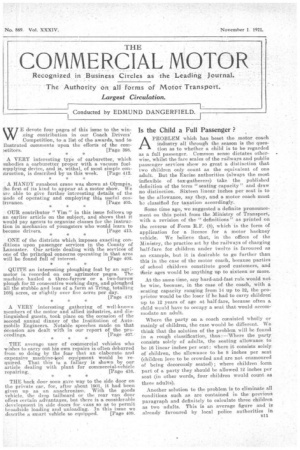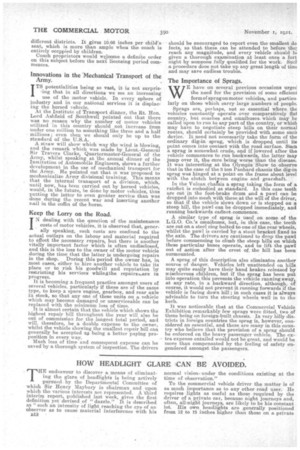W E devote four pages of this issue to the winning
Page 1

Page 2

If you've noticed an error in this article please click here to report it so we can fix it.
contribution in our Coach Drivers' Competition, to a list of the awards, 'and to Ilustrated ,comments upon the effort8 of the com Yetitors. [Page 398.
A VERY interesting type of carburetter, which embodies a carburetter proper with a vacuum fuel;upplying device, and is, withal, of most simple con itruction, is described by us this week. [Page 412.
A HANDY runabout crane was shown at Olympia, the first of its kind to appear at a motor show. We ire able to give further interesting details of the node of operating and employing this useful con trivance. _ (Page 405.
OUR contributor " Vim " in this issue follows up an earlier article on the subject, and shows that it would pay agents to organize classes for the instruction in mechanics of youngsters who would learn to become drivers. [Page 413.
ONE of the districts which imposes exacting conditions upon passenger services in the County of Lancaster. Our article dealing with the services of one of the principal concerns operating in that area will be found full of interest. [Page 402.
• QUITE an interesting ploughing feat by an ag-rimotor is recorded on our agrimotor pages. The machine hauled a three-furrow or a two-furrow plough for 33 consecutive working days, and ploughed all the stubble and leas of a farm at THng, totalling 166i acres, or slightly over five acres per day. [Page 419.
A VERY interesting gathering of well-known members of the motor and allied industries, and distinguished guests, took place on the occasion of the second annual dinner of the Institution of Automobile Engineers. Notable speeches made on that occasion are dealt with in our report of the pro ceedings. [Page 407.
THE average user of commercial vehicles who wishes to carry out his own repairs is often debarred from so doing by the fear that an elaborate and expensive machine-tool equipment would be required. That this is a fallacy is shown by our article dealing with plant for commercial-vehicle repairing. [Page 416.
THE back door soon. gave way to the side door on the private car, for after about 1901, it had been given up as an anachronism. With the goods vehicle, the drop tailboard or the rear van door offers certain advantages, but there is a considerable development in side doors for -vans so as to permit broadside loading and unloading. In this issue we describe a smart vehicle so equipped. [Page 409_
Is the Child a Full Passenger ? ,
APROBLEM which has beset the motor coach industry all through the season is the question as to whether a child is to be regarded as a full passenger. Common sense dictates other• wise, whilst the fare scales of the railways and public passenger services show so great a distinction that two children only count as the equivalent of one adult. But the Excise authorities (always the most inflexible of tax-gatherers) take the published definition of the term "seating capacity" and draw no distinction. Sixteen linear inches per seat is to be the allowance, say they, and a motor coach must be classified for taxation accordingly.
Some time ago, we suggested a definite pronouncement on this point from the Ministry of Transport, with a revision of the " definitions" as printed on the reverse of Form R.F. (8), which is the form of application for a licence for a motor hackney vehicle. We believe that, in the offices of the Ministry, the practice set, by the railways of charging half-fare for children under twelve is favoured as an example, but it is desirable to go further than this in the ease of the motor coach, because parties of school children constitute good customers, and tileir ages would be anything up to sixteen or more.
At the same time, any hard-and-fast rule would not be wise, because, in the case of the coach, with a, seating capacity ranging from 14 up to 32, the proprietor would be the loser if he had to carry children up to 12 years of age at half-fare, because often a child would have to occupy a seat that would accommodate an adult.
Where the party on a coach consisted wholly or mainly of children, the case would be different. We think that the solution of the problem will be found in a rough classification, thus :Where the party consists solely of adults, the seating allowance to be 16 linear inches per scat: where it consists solely of children, the allowance to be 8 inches per seat (children love to be crowded and are not enamoured of being decorously seated); where children form part of a party they should be allowed 12 inches per seat (in other words, four children would count as three adults).
Another solution to the problem is to eliminate all• conditions such as are contained in the previous paragraph and definitely to calculate three children as two adults. This is an average figure and is already favoured by local police authorities in
different districts. It gives 10,66 inches per child's seat, which is more than ample when the coach is entirely occupied by children. Coach proprietors would welcome a definite order on this subject before the next licensing period commences.
Innovations in the 'Mechanical Transport of the Army. ,
ITS potentialities being so vast, it is not surprising that in all directions we see an inerea,sing use of the motor vehicle. In every sphere of industry and in our national services it is displacing the horsed vehicle.
At the Institute of Transport dinner, the Rt. Hon. Lord Ashfield of Southwell pointed out that there was no reason why the number of motor vehicles utilized in this country should not increase from under one million to something like three and a half millions ; even then we should only be up to the standard of the U.S.A.
A strays, will show which way the wind is blowing, and the remark which was made by Lieut.-General Sir Travers Clarke, Quartermaster-General of the Army, whilst speaking at 'the annual dinner of the Institution of Automobile Engineers, shows a further development in the use of mechanical transport for the Army. He pointed out that it was proposed to mechanicalize Army divisional training. This means that the internal transport of a division, which, until now, has been carried out by honed vehicles, would, in the future, be done by motor vehicles, thus putting the latter to even greater service than was done during the recent war and inserting another nail in the coffin of the horse.
Keep the Lorry on the Road.
IN dealing with the question of the maintenance costs of motor vehicles, it is observed that, gener-ally speaking, such costs are confined to the actual outlays on the labour and material required to effect the necessary repairs, but there is another vitally important factor which is often undisclosed, and this is the loss to the owner of the motor vehicle during the time that the latter is undergoing repairs in the shop. During this period the owner has, in most cases, either to hire another vehicle to take its place or to risk his goodwill and reputation by restricting his services whilegthe repairseare in progress.
It is becoming a frequent practice amongst users of several vehicles, particularly if these are of the same type, to keep a spare 'engine, gearbox, and rear axle in stock, so that any one of these units on a vehicle which may become damaged or unserviceable can be replaced with the minimum loss of time. It is almost certain that the vehicle which shows the highest repair bill throughout the year will also he out of commission for the longest total period, and will, therefore, be a double expense to the owner, whilst the vehicle showing the smallest repair bill can generally be accepted as being a better paying proposition in every way. Much loss of time and consequent expense can be saved'by a thorough system of inspection. The drivers should be encouraged to report even the smallest de fects, so that these can be attended to before the reach any magnitude, and every vehicle should los given a thorough examination at least once a fort night by someone fully qualified for the work. Suel a procedure does not take up any great length of tine and may save endless trouble.
The Importance of Sprags.
WE have on several previous occasions urged the need for the provision of some efficient form. of sprag on motor vehicles, and particularly on those which carry large numbers of people. Sprags are, perhaps, not so essential where the vehicles constantly operate over comparatively flat country, but coaches and omnibuses which may be called upon to run to any part of the country, or which may have to negotiate steep hills on their normal routes, should certainly be provided with some such device. It need not necessarily take the form of the ordinary dig-in sprag, which is dropped until its point comes into content with the road surface. Such a sprag is somewhat crude, and if lowered after the vehicle commences to run backward6, the latter inay jump over it, the cure being worse than the disease. It was interesting at the Olympia Show to observe that in the case of the 3 ton Pa,nhard chassis the dig-in sprag was hinged at a point on the frame about level with the clutch between engine and gearshaft. In the Vulcan chalsis a sprag taking the form of a ratchet is embodied as standard. In this case teeth are cut in the foot-brake drum and a pawl can be dropped into mesh with these at the will of the driver, so that if the vehicle slows down or is stopped on a steep hill, the pawl can be dropped immediately, and running backwards eartnot.commence.
A similar type of sprag is used on some of the L.G.O. Co.'s omnibuses, but, in this case, the teeth • are cut on a steel ring bolted to one of the rear wheels, whilst the pawl is carried by a stout bracket fixed to the axle. The drivers are cautioned to drop the pawl before commencing to climb the steep hills on which these particular buses operate, and to lift the pawl out of action after the crest of, the hill has been surmounted.
A sprag of this description also eliminates another source of dancer. Vehicles left unattended on hills may quite easily have their hand brakes released by mischievous ehildren, but if the sprag has been put into operation this prevents the vehicle running away, at any rate, in a backward direction, although, isf course, it would net prevent it running forwards if the vehicle is facing down hill ; in such cases it is always advisable to turn the steering wheels well in to the kerb.
It was noticeable that at the Commercial Vehicle Exhibition remarkably few sprags were fitted, two of these being on foreign-built chassis. In very hilly districts in foreign countries the sprag is, however, considered an essential, and there are many in this country who believe that the provision of a sprag should be enforced on. the heavy passenger vehicle. The extra expense entailed would not be great, and would be more than compensated by the feeling of safety engendered amongst the passengers.
































